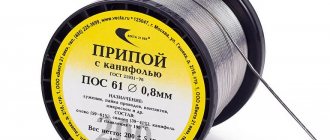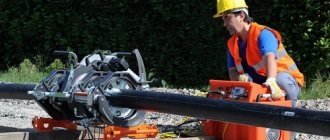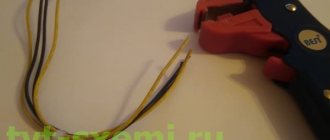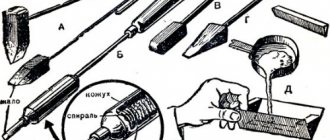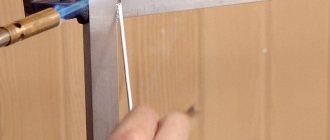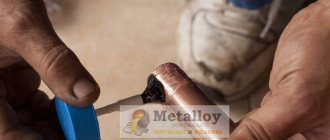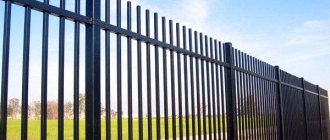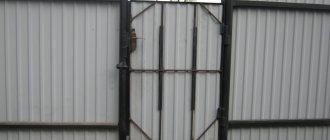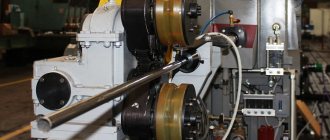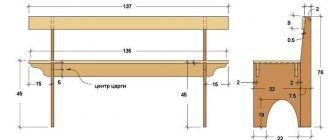Necessary tools and materials for soldering
To work at home, you will need to prepare in advance all the necessary tools and materials:
- electric soldering iron;
- nozzles and stands for a soldering iron of the appropriate size;
- a file or sharp knife for removing burrs;
- measuring ruler or tape measure;
- marker;
- pipe cutting scissors;
- shaver - a device for removing the reinforcing layer;
- special tool for chamfering;
- solder for soldering;
- fluxes and fittings;
- alcohol composition for degreasing.
Solder for soldering
Solder comes in the form of wire, foil, rod, etc. It is necessary to obtain a stronger weld on copper structures. It is made on the basis of tin, silver, zinc, lead, antimony or copper.
Depending on the melting point it is divided into:
- fusible;
- medium fusible;
- high fusible solder.
Fluxes and fittings
Fluxes are used in soldering to protect the metal surfaces being joined from oxidation. They are available in the form of a liquid, a dry mixture or a paste and differ in chemical composition, properties and purpose. For example, boric acid, zinc chloride, and hydrochloric acid are used to clean the surface of rolled copper and increase the fluidity of solder.
A protective film can be created using rosin, wax, and various resins.
Fittings are small-sized products that are placed on the ends of pipes that are connected by soldering. These include couplings, tees, crosses, contours, plugs, corners, etc. They must be made of the same material as the pipes themselves. And of course, it’s no secret that you can buy fittings at any plumbing store.
Cutting scissors
This type of tool has other names - pipe cutter, pipe shears or pipe cutter. It is designed for fast cutting of plastic products, providing a burr-free cutting edge, which simplifies preparation for the welding process.
There are 4 types of pipe shears, differing in design and price:
- precision pipe cutter with a ratchet mechanism. The device is used for cutting pipes with a diameter of no more than 75 mm;
- roller shears;
- automatic pipe cutter in the shape of a pistol;
- pipe cutter - guillotine.
Basic working methods
Considering that the quality of the connecting seam largely depends on the contact area, different connection methods are used for pipes of different diameters.
Soldering of polypropylene pipes is possible:
- using a coupling (another connecting element). Suitable for products with a diameter of up to 63 mm, as well as thin-walled ones;
- directly, with a butt seam - for large-diameter, thick-walled models.
In both cases, a tight connection is ensured by the diffusion of heated plastic.
To operate, a special heating device is used to increase the temperature of the plastic to the desired level.
Important: the second installation option requires significant professional skills and, as a rule, is used only in production. At home, the coupling (fitting) soldering method is used.
The main principles of the process are shown in the master class.
Tips for choosing and using a pipe soldering iron
When choosing a pipe soldering iron, you should take into account its technical parameters:
- power. Powerful devices are needed for welding large-diameter pipes; for domestic systems, in which the diameter of the products does not exceed 50 mm, you can purchase a device with a power of 0.6 - 0.8 kW;
- quality of coating of nozzles and technology of their use. The products to be welded can be easily removed from Teflon-coated nozzles, so it is advisable to choose a soldering iron equipped with just such nozzles. In addition, you should pay attention to the possibility of heating not only one, but two or three nozzles at the same time. This will significantly speed up the work;
- type of temperature controller. The soldering iron can be equipped with an electronic, capillary or bimetallic thermostat. It is better to choose a model with an electronic temperature controller, since the other two have too large a discrepancy between the set and actual heating temperature of the products.
The essence of the process and soldering methods
Soldering is used for hermetically connecting pipeline sections to each other, installing shut-off valves, control, measuring and safety devices.
Three soldering technologies are used to connect the ends of pipes and pipe fittings:
- diffusion method. Welding is carried out by heating and squeezing the connecting elements without melting the base material of the parts and the use of additional substances;
- soldering using electrical fittings. For connection, special fittings with a heating element are used. The soldering process occurs due to partial melting of the internal part of the electrical fitting under the influence of electric current;
- cold way. The elements of the heat pipe are connected using additional material - solder.
About the main methods of soldering PVC pipelines
To perform welding, craftsmen use the following basic techniques.
- "Butt".
- "Electro coupling".
- "Muff" The connecting coupling is purchased separately.
- Using so-called aggressive glue. One of the safest methods, which is simple.
- The most common options are using a specialized soldering iron.
These are different options, but their essence remains approximately the same. Due to the fact that diffusion occurs, polyvinyl chloride compounds are very durable.
This happens when the material is coated with glue, or one part of it is welded to another. Any do-it-yourself soldering of PVC elements consists of these stages.
Each welding process has its advantages and disadvantages. Conventional soldering technology is suitable for structures with different characteristics. An excellent choice for those who do everything themselves is the use of special glue.
There are exceptions, but special glue in most cases will not be suitable for a system that may have high pressure. The coupling also allows its use.
Step-by-step instructions for soldering plastic pipes
Pipeline soldering consists of three main phases - heating, joining, fixing and cooling of elements, the implementation of which requires certain preparation, compliance with temperature conditions and safety rules.
Security measures
During the soldering process, you need to follow basic safety precautions for working with power tools:
- the soldering iron must be protected from precipitation, dirt and splashes;
- Before connecting the device to the network, you must make sure that it is in working order and that the power cord and plug are intact;
- During work, you should ventilate the room and use thermal gloves;
- Do not touch exposed skin to heated surfaces.
Preparation of elements and parts
At this stage you need to do:
- cutting products into pieces of the required length;
- cleaning the cuts from burrs and thoroughly polishing them;
- degreasing the sections with an alcohol solution;
- drawing a notch by which it will be possible to control the depth of insertion of pipes into the apparatus;
Preparing the soldering iron
The device must be connected to the network in advance, the thermostat must be set to the desired position and the product must be heated to operating temperatures, depending on the type of plastic.
Typically, the heating time of the soldering iron is 30 minutes until the light goes out. The device will be ready for operation 10 minutes after reaching the set temperature.
When preparing the apparatus, it is also advisable to additionally control the temperature of the fittings and sleeves with a surface electric thermometer.
At what temperature should plastic pipes be soldered?
For soldering polyethylene products, the temperature regulator on the device is set to 220ºС, for polypropylene products - to 260ºС. If there is no regulator, you can adhere to the heating parameters of the parts from Table 1.
Table 1.
| Parameter name | Pipe diameter, mm | |||||
| 20 | 25 | 32 | 40 | 50 | 63 | |
| Product heating time, sec | 6 | 7 | 8 | 12 | 18 | 24 |
| Product heating time, sec | 4 | 4 | 6 | 6 | 6 | 8 |
| Cooling time, min | 2 | 2 | 4 | 4 | 4 | 6 |
Docking rules
When assembling joints, it is necessary to ensure that the edges are aligned so that the surfaces of both products coincide and the axis of the pipeline does not shift. The gap between the edges should be uniform over the entire diameter with a size of 2 - 3 mm.
Pipe connection
The heated parts are removed from the soldering iron nozzles and connected to each other, lightly pressing with their ends. The polymer will harden in 2-3 minutes.
Cleaning and cooling connections
The connection point should be in a stationary position until the plastic cools to a temperature of 38 - 42 degrees. To do this, the connected parts are fixed in a clamp or clip until cooling.
Cleaning of the deposits is carried out with a sharp knife after the joint area has completely cooled.
Checking the connection quality
At the end of welding, all joints are subject to visual inspection. A high-quality weld should have a smooth surface, without traces of porosity, cracks, folds and excessive shine that occur when overheated. The bead in the weld area must be continuous and uniform along the entire circumference of the joint and rise above the outer surface by no more than 2 mm - for products with a wall thickness of up to 10 mm.
The maximum bead height for pipes with larger wall thicknesses is 4 mm.
Nuances of work: how to solder plastic pipes without problems
The above instructions describe the general provisions for welding polypropylene pipes. But there are interesting points that can confuse an inexperienced master.
We work on the workbench and locally
Not all components of the future pipeline can be soldered comfortably on a prepared workbench. Of course, maximum work should be carried out there, and the point is not at all in the personal comfort of the master - this way there is less risk of incorrect connection of elements. But sometimes it is necessary to solder parts “in place”, so it is better to mark out the diagram of future communications on the wall, floor or ceiling in advance, and secure the clips that will hold the pipes in the desired position.
We fasten the welding machine
When inserting and removing heated elements, a tabletop “iron” that is not secured in any way will jerk in different directions. This leads to both problems with extracting fragments and burns (when trying to hold the falling apparatus), and its breakdown.
Therefore, it is better to fix the soldering iron on a workbench or desktop in any available way - using a “native” clamp or a clamp added to the design, self-tapping screws, and so on.
Cleaning is required!
One of the striking examples is the joining of products reinforced with aluminum not on the outside, but in the middle of the wall.
To properly solder such polypropylene pipes, it is necessary to strip the aluminum layer - but how to do this if it is between the layers of plastic and not outside?
For this, there is a special trimming tool that allows you to remove aluminum foil precisely between the layers.
The cutting edges, which “scrape out” the foil, are shifted towards the center of the product. Thanks to this, the aluminum is removed, the plastic remains in place - the pipe is ready for welding.
The photo shows what the joint looks like between prepared (right) and unprepared (left) fragments. It is clearly visible that in the first case the adhesion turned out to be dense, in the second the delamination is clearly visible. With short-term use, this defect does not matter, but for pipelines through which hot water is supplied (from a boiler or heating boiler), depressurization and failure of communications is possible.
The diagram demonstrates the consequences of a loose joint between two seemingly welded pipes, delamination of the product and swelling of the outer layer of polypropylene during operation.
Important: fiberglass reinforced pipes do not need to be stripped! This is due to the fact that the welding temperature adopted for polypropylene allows glass fiber to melt to the point of diffusion.
Correct cut
Sometimes users think that cutting the pipe obliquely - at an angle of 45 degrees - can increase the contact area and thereby strengthen the weld. This is actually true, but with this type of pruning problems arise:
- with the alignment of parts - it is difficult to correctly connect the pipe sections inside the coupling, a gap inevitably arises;
- with heating of the welded areas - an oblique cut does not allow the required fragment of the product to be completely placed on the heating element. One edge heats up less, the other more.
The last node is not welded!
This happens if an inexperienced welder inaccurately calculated the lengths and locations of pipeline fragments. When it is not possible to insert a mandrel with nozzles and a coupling between the last two elements to be welded, you can solve the problem differently - weld metal inserts into the elements to be joined.
Such a threaded pair with a union nut allows you to firmly and efficiently fasten two fragments and at the same time weld it in without any problems.
Wouldn't you, priest, chase something cheap...
An attempt to save money when purchasing pipes and fittings is fraught with leaks and swelling of pipes in the future, so it is better to purchase products from trusted manufacturers.
It is also necessary to avoid combining products from different companies - a slight difference in the composition or production technology of goods sometimes leads to critical problems in finished communications.
Other errors
Among the most “popular” errors are often found:
- excessive heating of elements. As a result, the pipe is severely deformed and closes the lumen of the coupling, thereby interfering with the free flow of water in the water supply system;
- refusal to degrease surfaces and/or clean them. In this case, diffusion does not occur over the entire surface; “islands” remain where the plastic has not fused. The result is failure of the connection when the pressure or temperature increases;
- water has not been removed (during the repair of an existing water supply system). This can be done using a rag and a warm (not hot!) stream of air from a household or construction hair dryer;
- loose connection. This happens if the pipe is not completely inserted into the fitting or the diameters do not match.
Another common mistake made by inexperienced craftsmen is not wearing protective gloves. The high heating temperature of polypropylene MUST require hand protection, and it is advisable to use gloves made of natural materials - preferably suede. They do not restrict movement and do not begin to smolder when heated, unlike cotton ones. Rubber and rubberized gloves cannot be used!
Typical mistakes are discussed in more detail in the video “How not to solder polypropylene pipes.”
Common mistakes
Soldering plastic pipes does not require special skills, but if you do not adhere to established norms and rules, you can still ruin the connection. Typical mistakes of novice masters are:
- using dirty attachments. If drops of molten polymer remain on the nozzles, then during the next welding they can wedge between the edges of the products and sharply weaken the connecting seam;
- residual water and dirt on the outer surface. They will prevent close contact of the surfaces of parts over the entire area;
- applying excessive force when combining parts. Part of the melt under excess pressure can be squeezed into the pipe and reduce its permeability;
- an attempt to clean up the sagging of molten plastic before the joint has completely cooled, which inevitably leads to deformation of the pipe;
- insufficient heating or overheating of the joint.
Features of pipes taken into account during installation
To choose the right method for soldering plastic pipes, it is necessary to take into account not only their diameter, but also the wall thickness. Therefore, before starting work, it is necessary to clarify the actual wall thickness of the selected product using markings and measurements (for verification).
For normal operation, it is necessary to clarify the data in the regulatory document according to the marking.
In general, technical data for pressure pipes made of thermoplastics is standardized by GOST R 52134-2003. However, each production has its own nuances, and for foreign manufacturers this standard does not work at all. Therefore, it is better to clarify the permissible temperature range (operating and emergency), they should not exceed the soldering temperature.
Next, according to the information received, it is necessary to clarify the heating duration when welding prepared plastic pipes and the heating temperature, as well as the cooling time of the parts.
Also, taking into account the increase in wall thickness with an increase in the nominal outer diameter, the table determines the width of the welded belt - that is, the length of the heated section. It must be the same for pipe and fitting, since diffusion (interpenetration of material particles at the molecular level) is required over the entire joined area. You can determine the width of the welded belt (the depth of insertion of the pipe into the coupling) and the size of the chamfer using the table.
Maximum insertion depth (actual width of the welded belt) without stripping.
Based on data on the type of plastic, the required heating level of the welding machine, or more precisely, the heating elements - paired nozzles, is set.
In some cases, the soldering temperature of polypropylene pipes is not 200...220 degrees Celsius, but about 260 degrees; this must be clarified with the manufacturer or seller.
Expert advice
To ensure maximum reliability of pipeline connections, experts advise adhering to the following requirements:
- it is correct to start welding work 10 minutes from the moment the soldering iron warms up;
- perform welding or soldering operations only at above-zero ambient temperatures;
- sections of pipes connected by welding must be allowed to cool, preventing them from moving relative to each other or twisting;
- For wall thicknesses greater than 6 mm, butt welding of products is performed using a double seam. With a smaller wall thickness, the joint can be sealed with one seam;
- all structural elements fixed by soldering must be from the same manufacturer, since they may differ in the composition of the ingredients in the raw materials, which will negatively affect the quality of the weld.
Soldering in hard-to-reach places and corners
When soldering pipes located in hard-to-reach places, for example, close to the surface of walls or ceilings, a special technique is used, which consists of sequential heating of the direct and counter sections of the connection with a soldering apparatus. It is necessary to warm up the flange of the straight section for a longer period of time so that it does not have time to cool down while the counter part of the workpiece is in operation.
A smooth line at corner joints of pipes can be achieved by using special corner adapters and fittings. In this case, it is important to very accurately mark in advance on the supply pipes the depth of their entry into the body of the corner piece.
Connecting plastic pipes without soldering
Plastic pipes do not have to be welded; they can be joined using a special adhesive. It is applied to the entire pre-degreased surface of the pipe section that will be inserted into the socket. In the bell, the inner surface is also degreased and covered with glue, but only 2/3. For better adhesion, the surfaces of the pipes under the adhesive joint are treated with sandpaper before degreasing.
The prepared part of the pipe is inserted into the socket until it stops and rotated 90 degrees. In this position, the parts to be glued should be held for 1 - 1.5 minutes until the glue sets.
The adhesive will dry completely within a few hours.
Plastic sewer pipes leading to the Tank septic tank can be connected using a compression fitting. With this method, the process of connecting pipes consists of the following steps:
- cleaning the top layer of the pipe from contaminants;
- chamfering at the end;
- loosening the union nut on the fitting and installing the end of the pipe into it;
- tightening the nut in the reverse position, at this moment the pipe is clamped (compressed) by the ferrule ring.
Fittings are fixed manually or using an open-end wrench. The applied force should not be excessive, otherwise the pipes may burst.
The socket method involves the use of a highly elastic sealing ring. The tightness of the connection is ensured by compression of the gasket between the walls of the socket and the smooth end of the pipe.
Welding large diameter plastic pipes
To connect pipes with a diameter of more than 50 mm and a wall thickness of 4 mm, butt soldering technology is used, which consists of simultaneous welding of the ends of 2 segments along the entire plane. The most difficult thing in this welding method is to correctly align the joints and ensure the required length of the gap between the parts.
Therefore, in the process of butt welding of large diameter pipes, guides or a pipe centralizer are used. It will provide high-quality and reliable fixation of sections for welding.
The work itself is carried out in the following order:
- pipe preparation and edge cleaning;
- securing elements in a pipe centralizer;
- welding of joints of products.
Soldering as a method of connecting PPR pipes
In the welding process, everything is important: diameter, soldering temperature of PP products, exposure time to the welding machine. But first you need to get acquainted with the basics of technology and learn how to use the tools
You cannot begin the soldering process without determining the type and dimensions of the material. We invite you to familiarize yourself with useful information that will help you choose the right polypropylene pipes and fittings, as well as install them, knowing the nuances and sequence of the process.
What do you need to know about polypropylene pipes?
Welding technology (or soldering - both terms are equally applicable) is ensured by the properties of polypropylene, a universal-purpose technical polymer. It is fusible, but after cooling and hardening it returns the characteristics of strength and tightness.
Pipes differ in diameter, wall thickness, color, and characteristics. Thanks to the range of diameters – 16-110 mm – any technical solution can be implemented.
For the improvement of private properties, small diameter products are used, most often up to 40 mm, less often up to 63 mm. The remaining pipes belong to the main pipes and have their own installation features
You can ignore the color of the polymer, since it is chosen by the manufacturer at its discretion, but the color of the stripes matters:
- blue – for cold water supply;
- red - for hot water supply and heating.
However, the basic information that you should rely on when purchasing and soldering pipes is indicated on the labeling. Polypropylene pipe material is designated by the letter combinations PPR, PP-H, PP-B, PPRC.
A diagram with which you can decipher the markings. Alphanumeric combinations indicate the type of pipe, diameter, wall thickness, permissible pressure - that is, values that are fundamentally important for soldering
Classification according to the nominal pressure, the maximum permissible for installation in specific conditions, helps to select products for home or industrial systems.
Based on this, there are 4 types of PPR pipes:
- PN-10 (with a nominal value of 1.0 MPa) - designed for transporting cold water. Sometimes they are used to install heated floors, provided that the coolant does not heat up above +45 °C.
- PN-16 (with a rating of 1.6 MPa) - used for assembling hot/cold water supply systems. The maximum permissible temperature is +60 °C.
- PN-20 (with a rating of 2.0 MPa) - can withstand temperatures up to +80-90 °C in pipelines protected from water hammer.
- PN-25 (with a rating of 2.5 MPa) - suitable not only for autonomous, but also for centralized water supply. The recommended maximum temperature is +95 °C, but higher temperatures can be tolerated.
It is better to overpay and purchase reliable pipes with a slightly superior value than to save money and buy material limited by temperature parameters.
When making pipes, the principle is applied: the higher the temperature of the coolant and the pressure in the system, the thicker the walls.
A table with which, knowing the outer diameter of the pipe, you can determine the wall thickness and inner diameter. In this case, the type of products according to the nominal pressure also matters.
This is the minimum knowledge needed to properly use PPR pipes. Let's move on to a brief description of the process.
Technological description of the soldering process
There are two types of polypropylene soldering - butt and coupling. The first is practically not used for the installation of home communications, since it has a complex technology and is used exclusively for connecting large-diameter main pipes.
In a cottage or apartment, sleeve welding is used, which is ideal for connecting sections of pipes/fittings with a diameter from 16 mm to 63 mm
The principle of welding is that two sections of pipe, approximately equal in diameter and wall thickness, are heated with a special tool and connected using a socket method.
The main feature: when cold, the coupling should be slightly smaller in diameter.
Scheme of step-by-step soldering of PPR pipes: Stage 1 – connecting parts and soldering iron (welding machine); 2 – heating to the required temperature; 3 – sealed unit
When heated, a melting zone of the polymer is formed
It is important that it covers only working surfaces adjacent to each other
Here it is important to quickly remove the parts from the tool and connect them to each other, due to which two segments are fused into one, followed by polymerization. The reliability of the connection depends on the time spent on the heating process and the correctly selected temperature.
